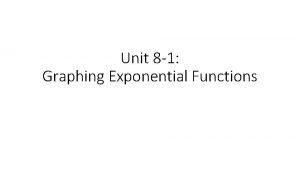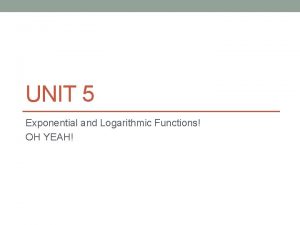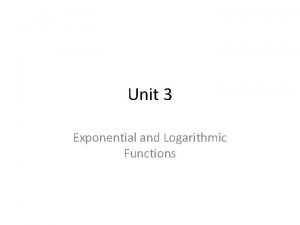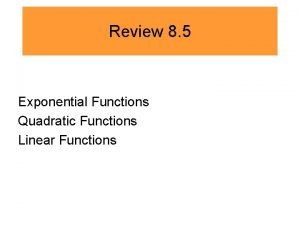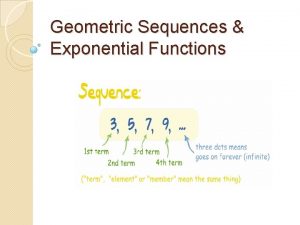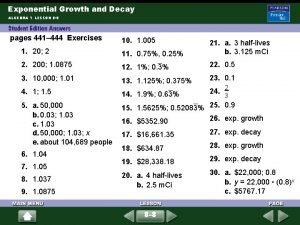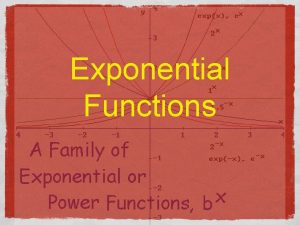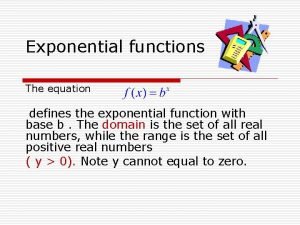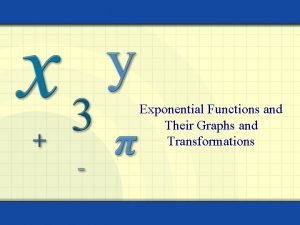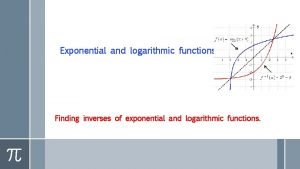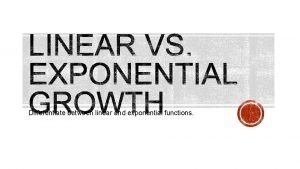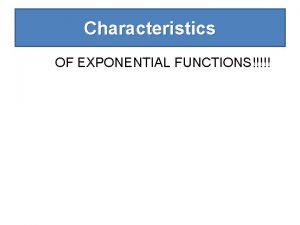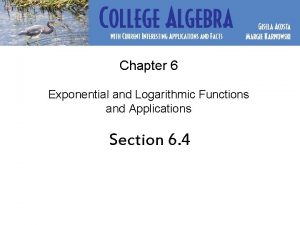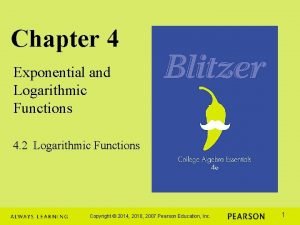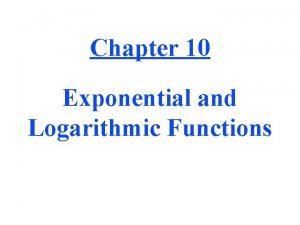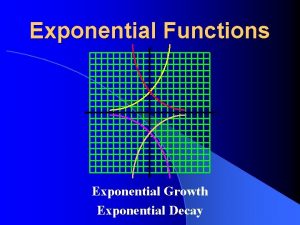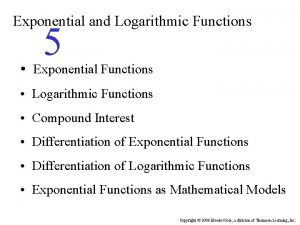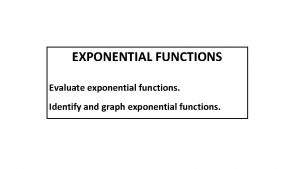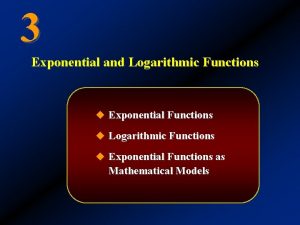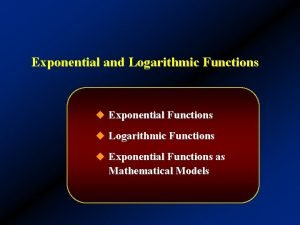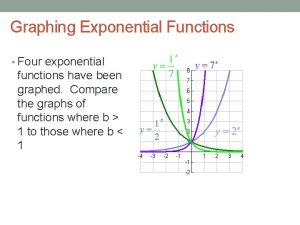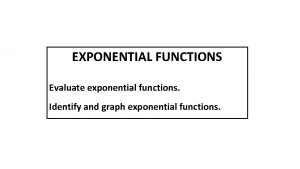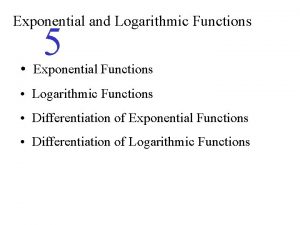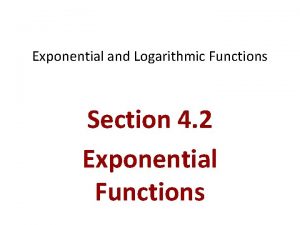Exponential Functions Section 4 1 Definition of Exponential


























- Slides: 26

Exponential Functions Section 4. 1

Definition of Exponential Functions The exponential function f with a base b is defined by f(x) = bx where b is a positive constant other than 1 (b > 0, and b ≠ 1) and x is any real number. So, f(x) = 2 x, looks like:

First, let’s take a look at an exponential function x y 0 1 1 2 2 4 -1 1/2 -2 1/4

Transformations Involving Exponential Functions Transformation Equation Description Horizontal translation g(x) = bx+c Vertical stretching or shrinking g(x) = c bx • Shifts the graph of f (x) = bx to the left c units if c > 0. • Shifts the graph of f (x) = bx to the right c units if c < 0. Multiplying y-coordintates of f (x) = bx by c, • Stretches the graph of f (x) = bx if c > 1. • Shrinks the graph of f (x) = bx if 0 < c < 1. Reflecting g(x) = -bx g(x) = b-x • Reflects the graph of f (x) = bx about the x-axis. • Reflects the graph of f (x) = bx about the y-axis. Vertical translation g(x) = -bx + c • Shifts the graph of f (x) = bx upward c units if c > 0. • Shifts the graph of f (x) = bx downward c units if c < 0.

Graphing Exponential Functions Four exponential functions have been graphed. Compare the graphs of functions where b > 1 to those where b < 1

Graphing Exponential Functions So, when b > 1, f(x) has a graph that goes up to the right and is an increasing function. When 0 < b < 1, f(x) has a graph that goes down to the right and is a decreasing function.

Characteristics The domain of f(x) = bx consists of all real numbers (- , ). The range of f(x) = bx consists of all positive real numbers (0, ). The graphs of all exponential functions pass through the point (0, 1). This is because f(o) = b 0 = 1 (b o). The graph of f(x) = bx approaches but does not cross the x-axis. The x-axis is a horizontal asymptote. f(x) = bx is one-to-one and has an inverse that is a function.

Transformations Vertical translation f(x) = bx + c Shifts the graph up if c > 0 Shifts the graph down if c < 0

Transformations Horizontal translation: g(x)=bx+c Shifts the graph to the left if c > 0 Shifts the graph to the right if c < 0

Transformations Reflecting g(x) = -bx reflects the graph about the x-axis. g(x) = b-x reflects the graph about the y-axis.

Transformations Vertical stretching or shrinking, f(x)=cbx: Stretches the graph if c > 1 Shrinks the graph if 0<c<1

Transformations Horizontal stretching or shrinking, f(x)=bcx: Shinks the graph if c>1 Stretches the graph if 0 < c < 1

You Do Graph the function f(x) = 2(x-3) +2 Where is the horizontal asymptote? y=2

You Do, Part Deux Graph the function f(x) = 4(x+5) - 3 Where is the horizontal asymptote? y=-3

The Number e The number e is known as Euler’s number. Leonard Euler (1700’s) discovered it’s importance. The number e has physical meaning. It occurs naturally in any situation where a quantity increases at a rate proportional to its value, such as a bank account producing interest, or a population increasing as its members reproduce.

The Number e - Definition An irrational number, symbolized by the letter e, appears as the base in many applied exponential functions. It models a variety of situations in which a quantity grows or decays continuously: money, drugs in the body, probabilities, population studies, atmospheric pressure, optics, and even spreading rumors! The number e is defined as the value that approaches as n gets larger and larger.

The Number e - Definition The table shows the values of as n gets increasingly large. As , the approximate value of e (to 9 decimal places) is ≈ 2. 718281827 n 1 2 2 2. 25 5 2. 48832 10 2. 59374246 100 2. 704813829 1000 2. 716923932 10, 000 2. 718145927 100, 000 2. 718268237 1, 000 2. 718280469 1, 000, 000 2. 718281827

The Number e - Definition For our purposes, we will use e ≈ 2. 718. e is 2 nd function on the division key on your calculator. y=e

The Number e - Definition Since 2 < e < 3, the graph of y = ex is between the graphs of y = 2 x and y = 3 x ex is the 2 nd function on the ln key on your calculator y= 3 x y = ex y = 2 x y =e

Natural Base The irrational number e, is called the natural base. The function f(x) = ex is called the natural exponential function.

Compound Interest The formula for compound interest: Where n is the number of times per year interest is being compounded and r is the annual rate.

Compound Interest - Example Which plan yields the most interest? Plan A: A $1. 00 investment with a 7. 5% annual rate compounded monthly for 4 years Plan B: A $1. 00 investment with a 7. 2% annual rate compounded daily for 4 years A: B: $1. 35 $1. 34

Interest Compounded Continuously If interest is compounded “all the time” (MUST use the word continuously), we use the formula where P is the initial principle (initial amount)

If you invest $1. 00 at a 7% annual rate that is compounded continuously, how much will you have in 4 years? You will have a whopping $1. 32 in 4 years!

You Do You decide to invest $8000 for 6 years and have a choice between 2 accounts. The first pays 7% per year, compounded monthly. The second pays 6. 85% per year, compounded continuously. Which is the better investment?

You Do Answer 1 st Plan: 2 nd Plan:
 Exponential functions definition
Exponential functions definition How to find constant ratio
How to find constant ratio Unit 8 review logarithms
Unit 8 review logarithms All real numbers graph
All real numbers graph Exponential and logarithmic functions unit test
Exponential and logarithmic functions unit test How to write logarithmic form
How to write logarithmic form Exponential linear quadratic
Exponential linear quadratic Geometric series exponential
Geometric series exponential Practice 8-1 exploring exponential models answers
Practice 8-1 exploring exponential models answers Domain of exponential functions
Domain of exponential functions 6-2 lesson quiz exponential functions
6-2 lesson quiz exponential functions Exponential math meaning
Exponential math meaning The exponential function f with base b is defined by
The exponential function f with base b is defined by Translating exponential functions
Translating exponential functions Growth or decay exponential
Growth or decay exponential Growth and decay exponential functions
Growth and decay exponential functions Inverses of exponential functions
Inverses of exponential functions Exponential behavior
Exponential behavior Linear vs exponential functions
Linear vs exponential functions Exponential function parent
Exponential function parent Exponential decay
Exponential decay Characteristics of an exponential function
Characteristics of an exponential function Exponential functions jeopardy
Exponential functions jeopardy Chapter 6 exponential and logarithmic functions answers
Chapter 6 exponential and logarithmic functions answers Chapter 4 exponential and logarithmic functions
Chapter 4 exponential and logarithmic functions Solving exponential and logarithmic equations worksheet
Solving exponential and logarithmic equations worksheet Lesson 10-2 exponential growth and decay
Lesson 10-2 exponential growth and decay



